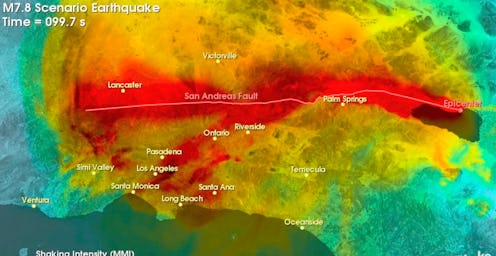News
How Far-Reaching Would California's Big Quake Be?

California's next major earthquake — dubbed, the Big One — has been on the minds of seismologists for years. A team of experts at the U.S. Geological Survey even turned the natural disaster into a large-scale earthquake drill. Dubbed the California ShakeOut Scenario, the 2008 drill imagines a magnitude 7.8 earthquake hitting the San Andreas fault in Southern California, long thought to be the epicenter of the Big One. Contrary to popular belief, such an earthquake would most likely not trigger a single a single tsunami and certainly won't split the state of California in two, nor would it cause the state to fall into the Pacific Ocean.
The quake would strike near the start of the San Andreas fault's southernmost point, affecting some of the most populated areas of the state, including Los Angeles and Orange County. Three minutes of shaking would result in the damage of major infrastructure including the splitting of sewage system and the downing of power lines. As many as 50,000 people could sustain injuries, though the USGS estimates total fatalities at 1,800. Being that the fault runs near major highway arteries, passage through major parts of I-15 and I-10 will be made impossible due to road damage. Likewise, even if bridges and other roadways don't collapse, they would most certainly be made impassable from the earthquake's impact.
Older buildings that aren't seismically retrofitted would sustain the most severe damage. An earthquake that severe would level most wooden and brick structures as well as older commercial facilities. Even the newest of high rises would experience damage from a 7.8 magnitude earthquake. As many as 1,600 fires could result from the earthquake and much of the state's water distribution would be severely damaged. The monetary toll the Big One would take could add up to $200 billion. The California ShakeOut Scenario does concede that "most of the damage is predictable and much is preventable," so long as citizens are prepared, their belongings are secure, and buildings are up to code.
An additional threat that has come to light is the potential for "super cycles" in which the Big One sets off a chain reaction of earthquakes erupting from other nearby faults, of which California has many. This scenario was posed by James Dolan, USC professor of earth sciences, who said that it's because of the state's relative seismic tranquility that a super cycle may occur:
This period of relative seismic quietude, during which we have been releasing in earthquakes far less energy than we have been storing from relative tectonic plate motions, cannot last forever. At some point, we will need to start releasing all of this pent-up energy stored in the rocks in a series of large earthquakes.
The question of a major California earthquake ultimately boils down to when the Big One will hit. In the meantime, the USGS, as well as the state of California as a whole, will continue to press the importance of earthquake preparedness by way of stringent building codes and drills like the California ShakeOut Scenario.
Images: USGS; Getty Images